A Comparison of Treatment Effects for Nonsurgical Therapies and the Minimum Clinically Important Difference in Knee Osteoarthritis: A Systematic Review
- PMID: 31415278
- PMCID: PMC6727942
- DOI: 10.2106/JBJS.RVW.18.00150
A Comparison of Treatment Effects for Nonsurgical Therapies and the Minimum Clinically Important Difference in Knee Osteoarthritis: A Systematic Review
Abstract
Background: The minimum clinically important difference (MCID) was developed to ascertain the smallest change in an outcome that patients perceive as beneficial. The objectives of the present review were (1) to compare the MCIDs for pain assessments used among guidelines and meta-analyses investigating different nonsurgical therapies for knee osteoarthritis and (2) to compare the effect estimates of different nonsurgical interventions against a single commonly-utilized MCID threshold.
Methods: Systematic and manual searches were conducted to identify guidelines and meta-analyses evaluating pain outcomes for nonsurgical knee osteoarthritis interventions. Individual treatment effects for pain were presented on a common scale (the standardized mean difference [SMD]). To evaluate the perception of the relative benefit of each nonsurgical treatment, the variation in MCIDs selected from the published MCID literature was assessed.
Results: Thirty-seven guidelines and meta-analyses were included. MCIDs were often presented as an SMD or a mean difference (MD) on a validated scale and varied in magnitude across sources. This analysis demonstrated that intra-articular hyaluronic acid, intra-articular corticosteroids, and acetaminophen all had relatively larger effect sizes than topical nonsteroidal anti-inflammatory drugs (NSAIDs). Higher-molecular-weight intra-articular hyaluronic acid had a greater relative effect compared with both non-selective and cyclooxygenase-2-selective oral NSAIDs. Evaluating the treatment effect estimates against a commonly utilized MCID revealed similarities in which observations attained clinical significance among treatments; however, this observation varied across the range of reported MCIDs.
Conclusions: The present review confirmed the variability in the MCIDs for pain assessments that are used across guidelines and meta-analyses evaluating nonsurgical interventions for knee osteoarthritis. This variability may yield conflicting treatment recommendations, ranging from rejecting treatments that are indeed efficacious to accepting treatments that may not be beneficial. Additional research is required to determine why some nonsurgical therapies are more consistently recommended in knee osteoarthritis guidelines than others as these findings suggest similarities in their effect estimates for pain. Relevant stakeholders need to reach a consensus on a standard approach to determining the MCIDs for these therapies to ensure that appropriate and effective treatment options are available to patients prior to invasive surgical intervention.
Level of evidence: Therapeutic Level IV. See Instructions for Authors for a complete description of levels of evidence.
Figures
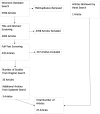
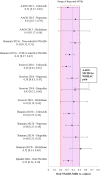

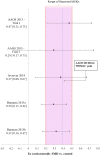

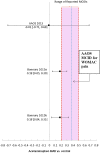
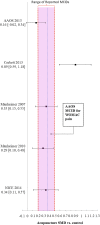
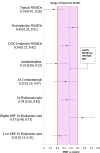
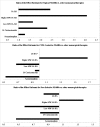
References
-
- NICE: National Institute for Health and Care Excellence. Osteoarthritis: care and management. 2014. https://www.nice.org.uk/guidance/cg177. Accessed 2019 Jan 4.
-
- Altman RD, Bedi A, Karlsson J, Sancheti P, Schemitsch E. Product differences in intra-articular hyaluronic acids for osteoarthritis of the knee. Am J Sports Med. 2016. August;44(8):2158-65. Epub 2015 Nov 17. - PubMed
-
- Jevsevar D, Donnelly P, Brown GA, Cummins DS. Viscosupplementation for osteoarthritis of the knee: a systematic review of the evidence. J Bone Joint Surg Am. 2015. December 16;97(24):2047-60. - PubMed
-
- Trojian TH, Concoff AL, Joy SM, Hatzenbuehler JR, Saulsberry WJ, Coleman CI. AMSSM scientific statement concerning viscosupplementation injections for knee osteoarthritis: importance for individual patient outcomes. Br J Sports Med. 2016. January;50(2):84-92. - PubMed
-
- Loew L, Brosseau L, Wells GA, Tugwell P, Kenny GP, Reid R, Maetzel A, Huijbregts M, McCullough C, De Angelis G, Coyle D; Ottawa Panel. Ottawa Panel evidence-based clinical practice guidelines for aerobic walking programs in the management of osteoarthritis. Arch Phys Med Rehabil. 2012. July;93(7):1269-85. Epub 2012 Mar 12. - PubMed
Publication types
MeSH terms
Substances
LinkOut - more resources
Full Text Sources
Research Materials

